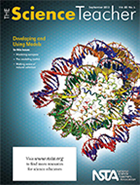Developing and using models
By Mary Bigelow
Posted on 2013-09-15
 Many of us remember building models in school—replicas of the solar system, atomic structure, or the double helix of DNA. But in the era of the Next Generation Science Standards, models should not just be built as an arts-and-crafts activity, but as a way to explore and explain phenomena. If this is a new idea for you and your students, the authors of the featured articles in this month’s issue provide strategies that illustrate these modeling experiences.
Many of us remember building models in school—replicas of the solar system, atomic structure, or the double helix of DNA. But in the era of the Next Generation Science Standards, models should not just be built as an arts-and-crafts activity, but as a way to explore and explain phenomena. If this is a new idea for you and your students, the authors of the featured articles in this month’s issue provide strategies that illustrate these modeling experiences.
Developing and Using Models in Physics has examples of students’ models and suggestions you can use in any class. You’ll notice that some are paper-and-pencil diagrams and explanations. The topics include electrostatics, forces and rockets, and buoyant forces. The authors note that “Rather than using trial and error, students were asked to create models of variables that they thought might affect how their rocket performed.” And then they did small-scale tests based on their models. [SciLinks: Using Models, Forces, Rocketry, Buoyancy]
Making Sense of Natural Selection describes a unit that culminates with students crafting explanations for how a population may have changed over time due to natural selection, well beyond reciting definitions. The article includes several observations and suggestions for teaching using models. “Instead of identifying models of particular things (like cells, the solar system, or volcanoes), we might want to talk about models for specific reasoning aims (like explaining inheritance or the behavior of matter).” [SciLinks: Natural Selection]
Models can be part of earth and space science, too. Modeling Sunspots describes how high school students in Korea used two types of modeling (data modeling and theoretical modeling) in their study of the Sun. In this extra-curricular club activity, students were challenged to construct models to explain why sunspots changed over time in four patterns (described in the article, along with a chart showing a classification scheme for sunspots). The article includes examples of the student models. [SciLinks: Sunspot Cycles, Solar Activity]
Linked In shows how modeling can be used as a link to other scientific practices, disciplinary core ideas, and crosscutting concepts. Models can include “physical representations, conceptual relationships, and simulations.” The example in the article describes how students used data from classroom activities and computer simulations on electrostatics to construct models of atoms. [SciLinks: Atomic Structure, Rutherford Model of the Atom]
Five strategies for making thinking visible are described in The Modeling Toolkit: small group models that are revised as the unit progresses, whole class consensus models, sticky notes and sentence frames, explanation checklists, and summary tables. The authors provide descriptions of these strategies, strategy for the classroom, and examples of student work.
Disclaimer: The views expressed in this blog post are those of the author(s) and do not necessarily reflect the official position of the National Science Teaching Association (NSTA).


